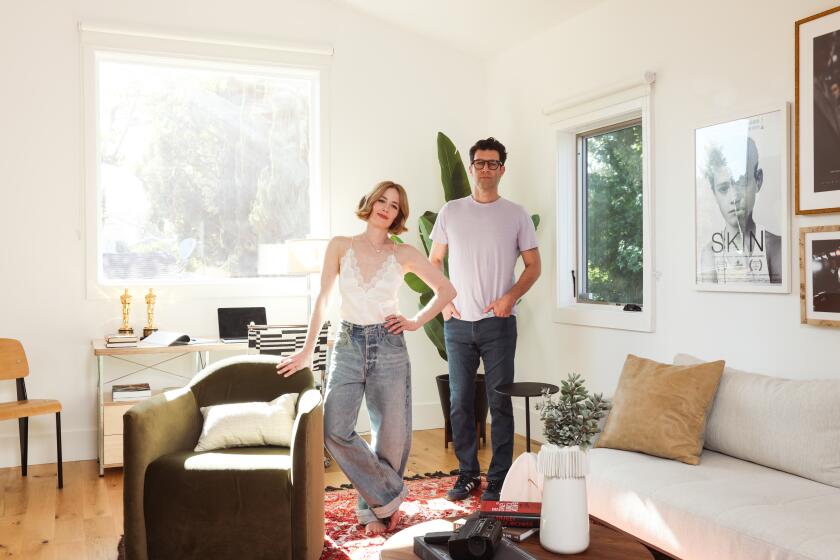A safe bet in Pasadena
There was new appreciation for old construction Tuesday when fledgling architectural preservationists got a close-up look at one of Pasadena’s most venerable landmarks.
Veteran restoration experts revealed to building design students the painstaking steps they took to maintain the integrity of the 100-year-old Gamble House during a recent cellar-to-rooftop renovation.
“We know that 50 years from now there will be new methods of doing things and better products to use,” architect Kelly Sutherlin McLeod told students from USC’s School of Architecture. “But at least you’ll know what we did here.”
McLeod was the project architect for the 10-month, $3.5-million restoration of the Gamble House, which was completed in 2004.
Workers repaired rotting beams, window sills and walls, plugged a stubborn, leaky roof drain system and restored the redwood-shingle siding to its 1908 luster.
Craftsmen involved in the preservation effort did it without creating any new nail holes or installing any modern fixtures or fittings, students were told.
McLeod, 47, of Long Beach, is intimately familiar with the historic American Arts-and-Crafts-style house, designed by architects Charles and Henry Greene. She lived there for two years in the late 1970s as a USC scholar in residence. Since 1966, USC has operated the Gamble House in partnership with the city of Pasadena. The 8,000-square-foot structure was deeded to the city by Gamble family members who had planned to sell it -- but changed their minds when the prospective buyer talked of painting the interior’s teak and mahogany walls white.
Several USC architecture students are picked each year to live at the house and help run it. Like many of them, McLeod said she noticed something other than the building’s architecture during her stay.
“There’s a presence in the house. The consensus is it’s Aunt Julia. She died in the house. And she lived here longer than anyone else,” she said of Julia Huggins, sister of homeowner Mary Gamble.
But it is the structure’s attention to detail and craftsmanship that is the real presence in the Gamble House, McLeod said.
“I knew the house was phenomenal, but I didn’t know all the reasons why until I moved in,” she said. “Living here, I was able to use the house like it was meant to be -- as a residence. I even used the kitchen when there were tours taking place.”
The kitchen is where McLeod discovered the Greene brothers’ unfailing attention to detail.
“The center island has drawers that slide out both sides. That makes so much sense. There’s a cabinet to store the dining table’s leaves in. The corner of the countertop in the butler’s pantry is clipped so you don’t bump into it when you’re working.”
Experts spent six years planning details of the restoration, right down to replacement of the home’s original window screens and some of its missing, 3-foot-long exterior shingles.
Each step of the actual work was carefully documented with photos and videotape, including the application of epoxy to repair rotted beams. The material was carefully sculpted to simulate wood grain.
“We wanted this to remain a 100-year-old home. We wanted to maintain the authenticity of the original construction. We didn’t want to erase history,” she said.
McLeod was in the three-story home’s airy attic answering students’ questions about the original construction when Tuesday’s earthquake struck, sending the house swaying.
At the rear of the wood-paneled attic room, Isabel Miesner, 23, of Westwood ducked under a heavy table as the shaking continued. Others in the group crouched between chairs.
When the shaking stopped, McLeod and USC architecture professor Kenneth Breisch hurried the students down two flights of ornately detailed stairs and out the house’s signature, stained-glass front doors.
“It probably wasn’t necessary for me to get under the table,” Miesner said as she stood outside the home after students reassembled on the front lawn. “But it was really cool to see how this house reacted to an earthquake.”
Kimberly Wiebe, 23, was amazed at the way the house rode out the rolling temblor.
“I didn’t feel scared. I didn’t hear anything breaking,” Wiebe said. “It was unbelievable the way that house moved. I think this house was the best place to be in an earthquake.”
Edward Bosley, director of the Gamble House, said the Greene brothers had the Great 1906 San Francisco earthquake in mind when they designed the home for David and Mary Gamble, of Procter & Gamble fame.
“The Greenes and other architects were thinking about seismic mitigation, although they didn’t call it that,” Bosley said.
McLeod said the house performed perfectly in the earthquake. “It moved with the movement, just the way it’s supposed to. They used ship-building details in building this house. It’s not so rigid that it breaks.”
Breisch agreed. “It’s solid and well built, obviously,” he said. “It’s resilient. It bends.”
The old-fashioned way.
--
More to Read
Sign up for Essential California
The most important California stories and recommendations in your inbox every morning.
You may occasionally receive promotional content from the Los Angeles Times.











